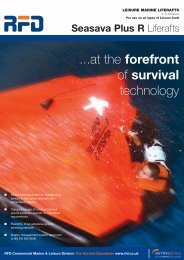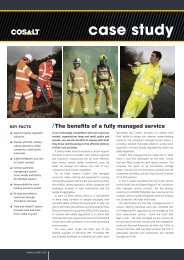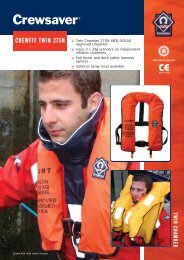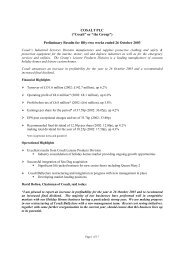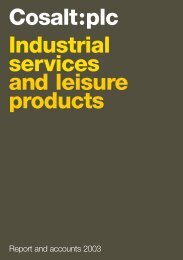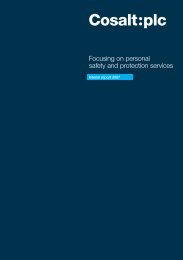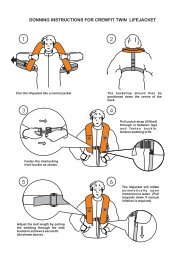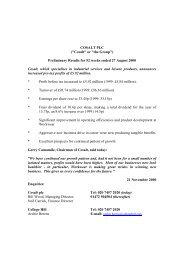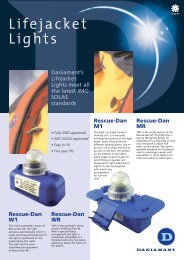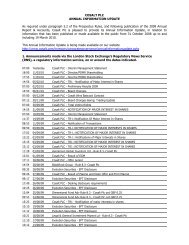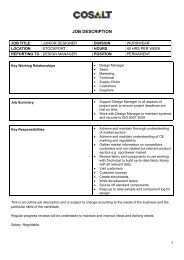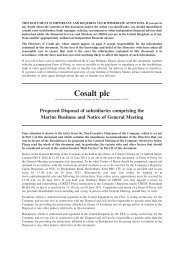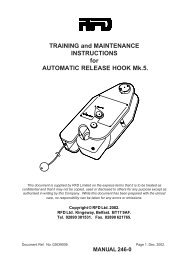Cosalt Marine We provide inspection and maintenance services for ...
Cosalt Marine We provide inspection and maintenance services for ...
Cosalt Marine We provide inspection and maintenance services for ...
Create successful ePaper yourself
Turn your PDF publications into a flip-book with our unique Google optimized e-Paper software.
Financial statements Notes to the financial statements<br />
b Basis of consolidation<br />
The Consolidated financial statements incorporate the financial statements of the Company <strong>and</strong> entities controlled by the<br />
Company (its subsidiaries). Control exists when the Group has the power, directly or indirectly, to govern the financial <strong>and</strong><br />
operating policies of an entity so as to obtain benefits from its activities. In assessing control, potential voting rights that<br />
are currently exercisable or convertible are taken into account. The financial statements of subsidiaries are included in the<br />
Consolidated financial statements from the date that control commences until the date that control ceases.<br />
All intra-group transactions, balances, income <strong>and</strong> expenses are eliminated on consolidation.<br />
c Business combinations<br />
The acquisition of subsidiaries is accounted <strong>for</strong> using the purchase method. The cost of the acquisition is measured at the<br />
aggregate of the fair values, at the date control passes of equity instruments issued, of assets given, less liabilities incurred<br />
or assumed, plus any costs directly attributable to the business combination. The acquiree’s identifiable assets, liabilities <strong>and</strong><br />
contingent liabilities that meet the conditions <strong>for</strong> recognition under IFRS 3 Business Combinations are recognised at their fair<br />
values at the acquisition date.<br />
d Goodwill<br />
Goodwill arising on consolidation represents the excess of the cost of acquisition over the Group’s interest in the net fair value<br />
of the identifiable assets, liabilities <strong>and</strong> contingent liabilities acquired. Goodwill is initially recognised as an asset at cost <strong>and</strong> is<br />
subsequently measured at cost less any accumulated impairment losses, measured annually (see page 57).<br />
On disposal of a subsidiary, the attributable amount of goodwill is included in the determination of the profit or loss on disposal.<br />
Goodwill arising on acquisitions be<strong>for</strong>e the date of transition to IFRS was tested <strong>for</strong> impairment at the transition date <strong>and</strong>, subject<br />
to the results of those impairment tests, have been retained at their previous UK GAAP value.<br />
e Other intangible assets<br />
(a) Computer software costs<br />
Acquired computer software licences <strong>and</strong> software development costs, are capitalised <strong>and</strong> amortised over the shorter of their<br />
estimated useful lives <strong>and</strong> the contracted term.<br />
(b) Other intangible assets (arising on business combinations)<br />
Trade names:<br />
Trade names are measured as the present value of any royalty payments saved as a result of ownership of the trade name.<br />
Trade names are amortised over the estimated useful life of the asset, typically 10-20 years.<br />
Customer <strong>and</strong> supplier contracts <strong>and</strong> relationships:<br />
Customer <strong>and</strong> supplier relationships are measured as the present value of cash flows attributable to the relationship after deduction<br />
of appropriate contributory assets charges. The relationship is amortised over its expected useful life, typically 6-12 years.<br />
f Foreign currencies<br />
Transactions in <strong>for</strong>eign currencies are translated to the respective functional currencies of Group entities at exchange rates at the<br />
dates of the transactions. Monetary assets <strong>and</strong> liabilities denominated in <strong>for</strong>eign currencies at the reporting date are retranslated<br />
to the functional currency at the exchange rate at that date. The <strong>for</strong>eign currency gain or loss on monetary items is the difference<br />
between amortised cost in the functional currency at the beginning of the period, adjusted <strong>for</strong> effective interest <strong>and</strong> payments<br />
during the period, <strong>and</strong> the amortised cost in <strong>for</strong>eign currency translated at the exchange rate at the end of the period. Nonmonetary<br />
assets <strong>and</strong> liabilities denominated in <strong>for</strong>eign currencies that are measured at fair value are retranslated to the functional<br />
currency at the exchange rate at the date that the fair value was determined. Foreign currency differences arising on retranslation<br />
are recognised in profit or loss, except <strong>for</strong> differences arising on the retranslation of available-<strong>for</strong>-sale equity instruments, a<br />
financial liability designated as a hedge of the net investment in a <strong>for</strong>eign operation, or qualifying cash flow hedges, which are<br />
recognised directly in equity.<br />
g Foreign operations<br />
The assets <strong>and</strong> liabilities of <strong>for</strong>eign operations, including goodwill <strong>and</strong> fair value adjustments arising on acquisition, are translated<br />
to euro at exchange rates at the reporting date.<br />
Foreign currency differences are recognised directly in equity. Since 1 November 2004, the Group’s date of transition to IFRSs,<br />
such differences have been recognised in the translation reserve (TR). When a <strong>for</strong>eign operation is disposed of, in part or in full,<br />
the relevant amount in the TR is transferred to profit or loss.<br />
Foreign exchange gains <strong>and</strong> losses arising from a monetary item receivable from or payable to a <strong>for</strong>eign operation, the settlement<br />
of which is neither planned nor likely in the <strong>for</strong>eseeable future, are considered to <strong>for</strong>m part of a net investment in a <strong>for</strong>eign operation<br />
<strong>and</strong> are recognised directly in equity in the TR.<br />
<strong>Cosalt</strong> plc Annual report & financial statements 2008<br />
45



